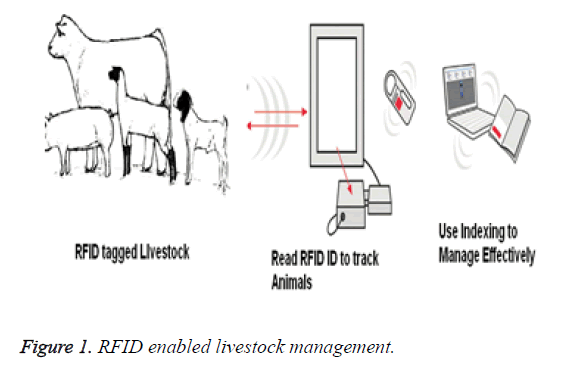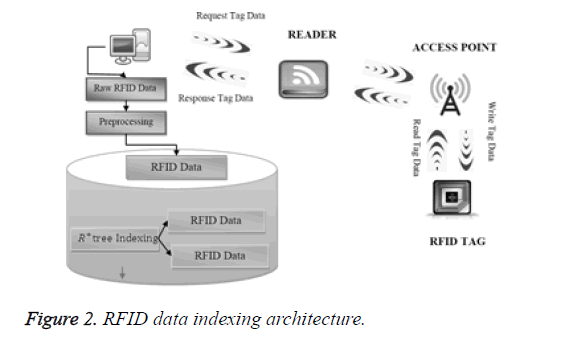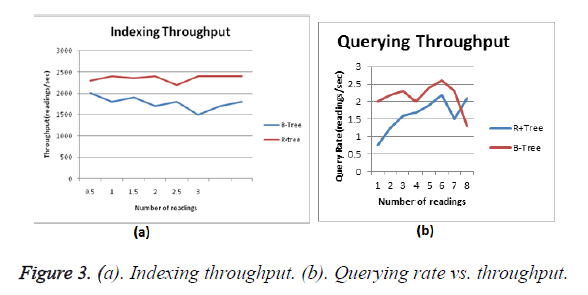Research Article - Biomedical Research (2017) Volume 28, Issue 6
Livestock monitoring using RFID with R+ tree indexing
Maria Anu V* and Aroul Canessane RFaculty of Computing, Sathyabama University, Old Mahabalipuram Road, Chennai, India
Accepted on October 22, 2016
Abstract
RFID is an emerging innovation and has viable connection to animal tracking. A sensor system which utilizes remote innovation is proposed for checking the livestock. Using RFID Livestock can be monitored efficiently against missing animals and new animals can be included in stock and the vaccination procedures can be monitored in a regular basis. This paper contributes and delineates the other method for farm environment monitoring. RFID tagged animals are associated with a reader in a defined range. The amount of RFID information in such a situation is vast. This scenario calls for more calculation and time that are expected to take out profitable data from RFID livestock management system. Consequently, this analysis concentrates on the indexing of the colossal measure of RFID query processing. Here, “R+ tree indexing technique” is put into use to incite the RFID information recovery from the RFID information stockroom. This method comprises of root node, intermediate and leaf node. Every leaf node is shaped as Minimum Bounding Rectangle (MBR) that incorporates information article and its values. Additionally, leaf node stores the Minimum Bounding Rectangle (MBR) and doesn't store the genuine RFID information object. Implementation results show that R+ tree indexing method produces high indexing throughput and less query processing time.
Keywords
Animal tracking, Farm management, RFID tag, Data base indexing, R+ tree indexing.
Introduction
The interest for animal ID and traceability have always acquired a good response, due to quality control and welfare administration of agricultural animals. Further, the sensational impacts of irresistible sickness and the rural economy have highlighted the significance of observing stages of animal capital. The wide selection of advancement on RFID and institutionalization has laid the path for the utilization of innovation through RFD for providing the mechanical structure, over which accurate and intense complex administration of animals can be performed. Utilization of innovation through RFID in any living creature has been followed as practice for years with most of the nations around the globe. Innovation through RFID is utilized to track farm animals and wild creatures, while there are endeavours to institutionalize the strategies so that the particular RFID label is utilized. In order to utilize the advancement in data mechanical system completely and corresponding advances in FARMA venture, the versatile process has coined innovation through RFID which in turn embraces the remote and portable system administration.
The main purpose of the configuration and its framework is the mix of cutting edge cell phones with an extensive information data administration that takes into account disseminated capacity and handling of animals with its hereditary information. Keeping this in view, apart from the viable objective, a straightforward approach towards obtaining a useful and industrially exploitable result has been explored by having the probability of preserving animal related renewable information (as a rewritable RFID tag)[1-7].
Animal tracking application creates a tremendous volume of useful information which is prepared through three stages. An initial step is to channel the voluminous information consequent to which the handling of information is done which gets converted into semantic information finally. With this, RFID information is coordinated into farm management applications. In the RFID stockpiling administration, numerous multidimensional indexing techniques are proposed. However, many of these techniques are not adjusted by the primary database retailers due to the high cost of reconciliation and unpredictability. R-tree and R*-tree are the most widely recognized indexing techniques from R-tree crew. Numerous tests demonstrated that R*-tree offers the best query performance. The main zone where R*-tree falls behind in comparison to other techniques is the development time which is mainly due to the excessive consumption of time for reinsertions. In this paper, effective query processing using R+ tree indexing has been achieved.
Related Works
Extreme scrutiny is done on the RFID administration for expanding the execution of the information recovery. Few procedures are mentioned in this subsection. A novel warehousing model is proposed to prepare the path forward for the object move, where tables are joined ordinarily to acquire the aggregate parameters by the side of the main activity. Subsequently, these procedures use to diminish the cost, however this current RFID data processing system is not materialized as movement of animals is in immense gatherings. At the point when animals start moving from one area to the next, animal positions are accounted. There are numerous indexing plan methodologies, for example, HR-tree [8], MV3R-tree [9] and 3D R-tree [10] for proficient inquiry preparing about the verifying positions of the moving animal.
All these indexing plans are known as the region based indexing plans, which utilizes the R-tree method [11]. These techniques delineate better execution for time scale and separation range queries. These direction questions are recovered utilizing the direction indexing saving plan keeping in mind the end goal to improve the query processing which incorporates an indexing plan like OP-tree [12] and TB-tree [13]. All of these indexing plans utilize the property known as only way for storing every leaf node.
With this, RFID framework the article identity is given as an estimation of the readings. The primary thought process of the framework is to exchange high volumes of loud readings into precise area occasions. VG-bend acquainted with multidimensional element grouping essential file system that can effectively get to and control RFID information [9]. The proposed thought is not receptive to the request or number of extents of measurements restricted in the question and is just made inside of present business database administration framework. It can handle the colossal volume of multidimensional RFID information. This puts away the RFID information in multidimensional space license handling of a wide scope of queries. Then again, this strategy doesn't give full RFID information recuperation execution when expanded for multidimensionality.
Proposed Work
RFID farm management
In this paper, we utilize active RFID innovation. It identifies the animals which are lost with the assistance of the RFID labels embedded in the animals and readers which are utilized to recognize the RFID tags. Active RFID is utilized to distinguish the animals and it likewise demonstrates the area where the animals are found as of now. Voluminous information can be overseen and put away which is utilized for recognizable proof. Identity of the animals and its records are kept away in the database. Database holds the advancement of animal information. It is separated into ingress and egress capacities. Ingress is the conception of new animals and egress is passing of the animals in the ranch.
The database holds data about the animals and records the history of their information. It oversees information about stockbreeders, immunization and different functionalities. In this paper we distinguish and look at the qualities of creatures with the assistance of the information present in the database and store the analysed substance again in the database that is ready to be inoculated. High efficiency animals can be cross-breeded with the goal that we get a quality item and can expand the generation (Figure 1).
Separating of this information should be possible utilizing some edge esteem as a part of the creation field so we can recognize the creatures effortlessly. Sorting calculations can be utilized to discover the efficiency of creatures from the database. RFID is utilized for cautioning the power about the animals when they cross the fringe of the ranch and they must be inoculated. Database administration is the fundamental point of this paper which is furnished by veterinarian and the agriculturist by providing creature based facts in it.
RFID data indexing
This topic is to investigate the idea of RFID information indexing technique in animal farm management. At first, the host framework sends the RFID label solicitation to RFID tag reader. The reader is getting the crude RFID tag from the moving animals. At this point, the reader advances the received tag to the host server. Eventually the received raw RFID information is pre-prepared to evacuate pointless data from the RFID tag. In the end, the pre-prepared RFID tag will coordinate with RFID information to overhaul the area or following the moving animal location. The proposed method has additionally two primary information structures; the first is the R+ tree indexing execution and the second is query search processing. They are converged to encourage the hunt procedure to the client and help him to get the full data of RFID label information. As an animal being followed and observed with applications that disseminates into numerous topographically isolate locales, which will have sheer volume of information represents an adaptability challenge. This approach acquires both deferral of noting questions and high correspondence costs without indexing techniques (Figure 2). In this work, we propose a novel list approach for identifying an animal using R+ tree system. Along these lines, this performs derivation and inquiry preparation on RFID streams as the animals are getting watched. An item occasion stream is delivered from raw RFID information stream, portraying the area and compartment of every item. Question handling runs consistently on the item occasion stream and other sensor streams to give back all answers.
R+ tree data indexing
R+ tree indexing has steps, where at first the RFID label ID is considered for indexing the RFID information. RFID information is checked at first on the off-site that it is available in the nearby most extreme bound rectangle and then returns to the indexing results. The benefit of indexing RFID information holds good until it is comparing RFID tag from the information stockroom.
Input: the RFID tag id stream of animals
Output: the indexing information of an animal
1: if O is stored locally
2: return its indexing information
3: i ← 1
4: p=O. id. Sub (1, Lp-i)
5: while true
6: Res= O at node (hash (p))
7: if Res is not nil return Res
8: else
9: i++, p=O. id. Sub (1, Lp+i)
Results and Discussions
This section presents exploratory consequences of the proposed indexing strategy and query processing. The effectiveness of our proposed model has strategies that can be shown by the response time and average maintenance cost per query result. The maintenance cost implies the expense to keep up and redesign our proposed data structure in light of approaching RFID readings which can be acquired with no query. The response time can be assessed by the query processing cost and the maintenance cost at a moment that a query is activated.
Scalability: The proposed method further test the scalability of our inference system by using larger numbers of animals in the simulation with above mentioned system configuration. Our RFID data processing system can scale to 100,000 animals per warehouse while keeping up with stream speed, totalling 1 million objects over 10 databases. The above reported results for accuracy and communication costs stay true (Tables 1 and 2). The RFID reader reads every second and spends 10 seconds scanning each room. Given such reduced room readings, our proposed system can scale to 1.21 million animals per warehouse while running at stream speed, totalling 12.1 million animals over 10 warehouses.
| S. No | Number of requested readings | Retrieved query results |
|---|---|---|
| 1 | 17000 | 16789 |
| 2 | 25000 | 24009 |
| 3 | 30000 | 29978 |
| 4 | 45000 | 44322 |
| 5 | 68000 | 67546 |
Table 1. Number of RFID tags retrieved after R+ tree Indexing.
| S. No | Number of requested readings | Query processing time (ms) |
|---|---|---|
| 1 | 17000 | 55 |
| 2 | 25000 | 73 |
| 3 | 30000 | 82 |
| 4 | 45000 | 92 |
| 5 | 68000 | 115 |
Table 2. Number of RFID tags retrieved vs. Query processing time (ms).
Figure 3a shows the indexing rates of the two techniques with respect to the number of readings in the index. As expected, serialization has the highest throughput, and B tree has the lowest. Figure 3b shows the query throughput of the two techniques with respect to the number of readings in the index.
The indexing cost, measured by the total volume of queries and their results transferred over the network, is considered to study the feasibility of the proposed R+ tree indexing algorithm and related data structures. Initially, the proposed method concentrated on the indexing cost to verify that the architecture is scalable. In this test, continuously added new nodes into the network until the size of the network reached 512. When a new node joined the network, a specific number of objects were generated on the node and the indexing process started. After a random period of time, the new node moved 10% of the objects to a randomly chosen destination. The proposed system collected the total volume of messages transferred during the whole process. It also ran the test 10 times and for the ith (1 ≤ i ≤10) time, the number of objects generated at each node is 500 i. As we can see from Figure 3a, the indexing cost of the R+ tree indexing algorithm increases much slower than the individual indexing algorithm. This section also studied the performance of the indexing algorithms under different network sizes. In the experiment, the number of objects generated at each node is fixed to 5000 and the network size varies from 64, 128, 256, to 512. The result in Figure 3b also shows that with the increase in network size, the indexing cost of the R+ tree indexing algorithm increases while the individual indexing algorithm shows a horizontal line (due to the fixed data volume). The reason is that when the network size increases, Lp increases as well, which leads to an increase in the number of groups (2 Lp) and the messages to be transferred. Generally, the performance degrades when the ratio of data volume to network size becomes smaller. As we can see, when the size of the network increases, the indexing cost of the R+ tree indexing algorithm becomes closer to that for the individual indexing algorithm. However, in reality, particularly large-scale applications, there are many more objects than nodes. These applications can take advantage of the benefits brought by our proposed R+ tree indexing approach.
Conclusions
This research work introduces novel RFID tag based R+ tree indexing technique and query processing for the RFID tagged animal tracking applications. The R+ tree indexing technique is utilized to reduce query processing time. The experimental results illustrated the accuracy, efficiency, and scalability of the proposed indexing technique. In future work our work reaches out to probabilistic question handling, misuse on-board label memory to empower anytime, anyplace questioning, and investigate smooth relations between other information issues. The trial results demonstrate the execution change of the proposed strategy, contrasted and existing inquiry files.
References
- Athanasios SV, Charalampos ZP, Alexander BS, Vasileios AN, Eftychia MX. A complete farm management system based on animal identification using RFID technology in National Technical University of Athens. Comp Electr Agri Elsevier 2009; 70: 380-388.
- Luca C, Riccardo C, Luca M, Luigi P, Stefano P, Ilaria SLT. Smart RFID antenna system for indoor tracking and behavior analysis of small animals in colony cages. IEEE Sens J 2014; 14: 1198-1206.
- Stevan S, Gordana O, Ivana S, Marija RS, Snezana T, Denis K. Dairy cow monitoring by RFID. Sci Agric J 2012; 69: 75-80.
- Trevarthen A, Michael K. The RFID-enabled dairy farm: towards total farm management. Int Conf Mob Busin 2008; 241-250.
- Pourvoyeurl K, Stelzer A, Gassenbauer G. The local position measurement system LPM used for cow tracking. Proc IEEE Int Conf Multisensor Fusion Integr Intell Syst 2006; 536-540.
- Jeong-Hwan H, Hyun JK, Meong-Hun L, Hyun Y. A design of RFID/USN based pig house monitoring system for environmental conditions and bio-information. Korea Inst Commun Inform Sci J 2009; 406-409.
- OConnor MC. Danish dairies adopt RFID to improve yield. J RFID 2009; 1-4.
- Yufei T, Papadias D. MV3R-Tree: A spatio-temporal access method for timestamp and interval queries. Proc Int Conf Very Larg Data Base 2001; 431-440.
- Nascimento MA, Silva JRO. Towards historical R-trees. Proc ACM Symp Appl Comp 1998; 235-240.
- Theodoridis Y, Vazirgiannis M, Sellis T. Spatio-temporal indexing for large multimedia applications. Proc Int Conf Multimed Comp Sys 1996; 441-448.
- Guttman G. R-trees: A dynamic index structure for spatial searching. Proc ACM Sigmod Int Conf Manag Data 1984; 47-54.
- Zhu H, Su J, Ibarra OH. Trajectory queries andoctagons in moving object databases. Proc Int Conf Inform Knowl Manag 2002; 413-421.
- Pfoser D, Jensen CS, Theodoridis Y. Novel approaches to the indexing of moving object trajectories. Proc Int Conf Data Base 2000; 395-406.
- Justin T. Indexing RFID data using the VG-curve. Proc Austr Datab Conf Melbourne Australia 2012.


